A Capstone Project submitted to Times School of Media, Bennett University
In partial fulfillment of the requirement for the degree
Bachelor of Arts in Mass Communication and Journalism
By: Harshit Mansukhani
Under the supervision of Professor Sunil Saxena
Head of Department, Times School of Media
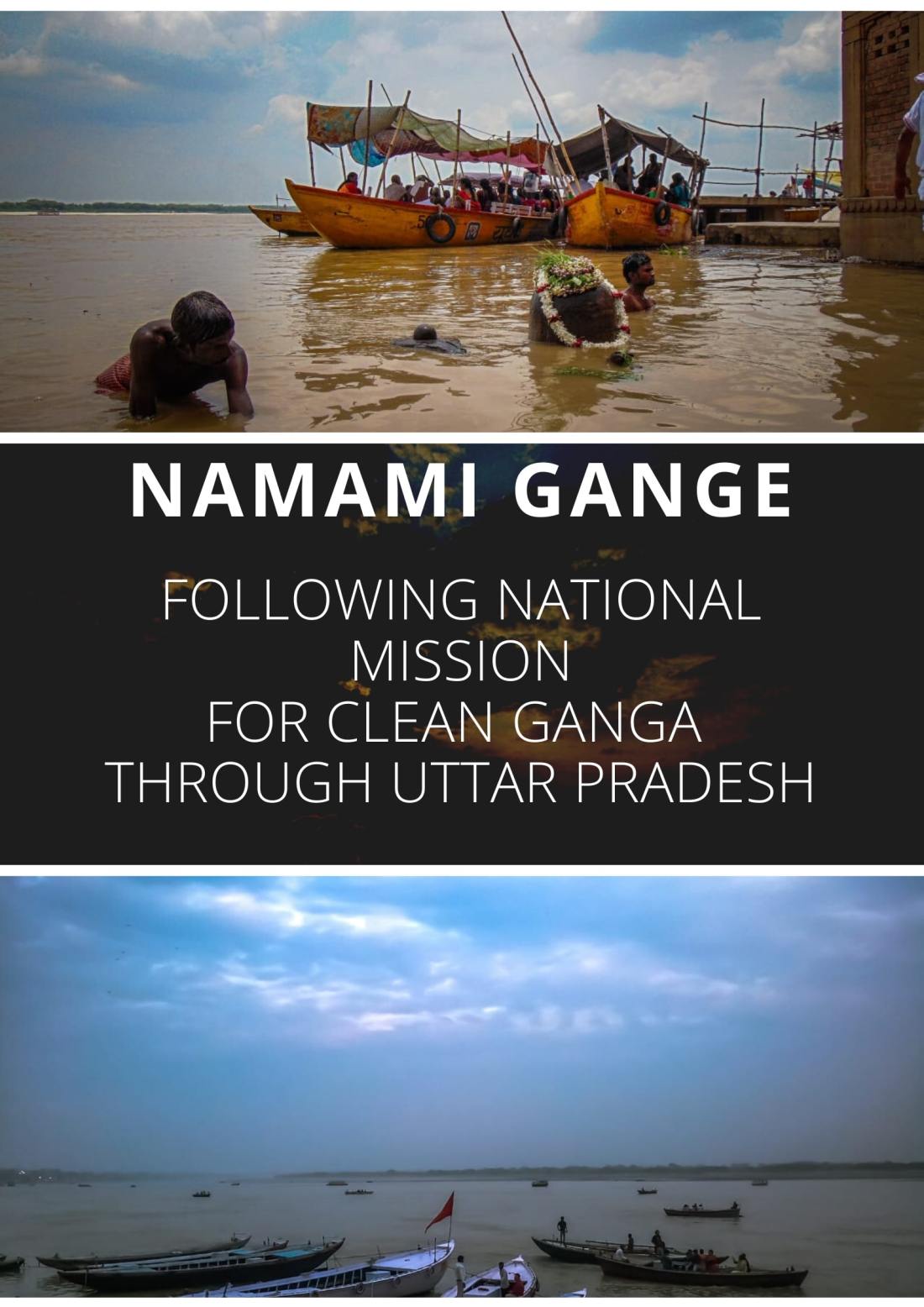
Namami Gange: Following the National Mission for Clean Ganga through Uttar Pradesh
Scope of the Project
-
Dedication
-
Acknowledgments
-
Approval page
-
Special Thanks To
-
Overview
-
Chapter 1 – Ganga -Before and After Kanpur
-
Ganga Before Kanpur
-
Vicious Cycle of Ganga Depletion
-
Ganga in Kanpur
-
Understanding failures of Ganga Action Plan (GAP) and the journey after Kanpur
-
-
Chapter 2 – On Road to Sangam
-
Environmental and Social Assessment
-
Is Ganga a Living Entity
-
-
Chapter 3- In Varanasi: Ganga Looking for Moksh
-
The Model Ghat
-
Ganga a living entity?
-
Ganga During and After Coronavirus Pandemic
-
-
In A Nutshell
-
People who helped during the project
-
Bibliography
Dedication
I dedicate my Capstone Project to the loving memory of my mother, Vandana Mansukhani, whose words of encouragement and push for tenacity still ring in my ears. My mother guided me on the path of truth, justice, and empathy but asked me to never lose sight of my goals. Her words have been my lighting guide throughout my university life and continue to be with me in a sacred chest that I will carry for the rest of my life. This project is a dedication to her painstaking upbringing of mine as I work hard to live her dreams.
I would also like to dedicate the project to my father Rajesh Mansukhani, who guides me towards being an all-rounder and achieve excellence in education. He is more like a friend and a brother to me who sets the highest bar for me each time.
Acknowledgment
Professor Sunil Saxena, Head of Department, Times School of Media has always guided me personally from the very first day of the course. Prof. Saxena has guided me almost through all my projects, endeavours, and always encouraged me to think out of the box.
I am lucky to say that I have been given special attention by him in every task, his positive feedback on my assignments have helped me improve dramatically within three years of my higher education.
Prof. Saxena has provided me with the best opportunities in the industry for my internships and placements. The learnings of these training will be justified and used in the project.
I express my sincere gratitude to Professor Saxena for his personal attention and mentorship throughout this project.
Approval Page
We certify that we have read this project and that, in our opinion, it is satisfactory in scope and quality as a capstone project for the degree of Bachelor of Arts in Mass Communication and Journalism
Capstone Committee:
___________________________________
Sunil Saxena
Head of Department
Times School of Media
________________________________
Members of the capstone evaluation panel
Approved
Date
University Stamp
A Special thanks to
Justice Sunil Ambwani
Former Chief Justice of Rajasthan High Court (2015-2016)
Judge at Allahabad High Court (2001-2014)
Professor C.R. Babu
Professor Emeritus & Ex-Pro-Vice-Chancellor
University of Delhi
Mallika Bhanot
Ganga Activist with Ganga Avahan NGO
Bhim Singh Rawat
Assistant Coordinator
South Asia Network on Dams, River and People (SANDRP)
Sanjam Cheema
Sr. Consultant
Communication and Public Outreach
National Mission for Clean Ganga
Shilpi Tandon
Senior Manager
Corporate Communications
GAIL India Limited
I thank all these people for the invaluable inputs to this project
Overview
World’s largest followed religions-Hinduism, Christianity, Sikhism, Islam- and almost all other religions have a reference to “holy” nature of water with special healing powers. The unknown source of this water, mythological allusions, and human dependence have further enhanced the relevance of the water
For India, this holy water is often called “Ganga Jal” (Water of the river Ganga). The river Ganga occupies the central position in the cultural ethos of Indian land. Legend says that the river descended on Earth from heaven after the long and tiring prayers of King Bhaghiratha, of the Ikshvaku dynasty, who wanted the salvation of his deceased ancestors.
Ganga originates at a height of 3,892 m (12,770 feet) at Gaumukh in the Himalayas. It originates from the Bhagirathi stream and travels 2525 km across much of north India before flowing into the Bay of Bengal.
From time immemorial Ganga has been the river of faith, pilgrimage, and salvation. Millions of Indians consider its waters as sacred. Even today Indians carry Ganga water to their homes and abroad for its curative and sacred nature.
However, with the turn of the modern age and the introduction of industries, the Ganga has become polluted and is one of the most polluted rivers of the country. In 2014, the Government of India launched a Rs 20,000 Cr. flagship project under the name of “Namami Gange” or “National Mission for Clean Ganga” to fulfill the twin objectives of effective abatement of pollution, conservation, and rejuvenation of the Ganga River. (Gange, 2019)
The Mission stands on eight pillars that include sewage treatment, river-surface cleaning, afforestation, industrial effluent control and monitoring, riverfront development, bio-diversity, public awareness, and Ganga Gram. (Gange, 2019)
National Mission for Clean Ganga has been in news since 2014. However, no particular news story has covered the progress of the mission. National Mission for Clean Ganga provides a great opportunity to talk to biological experts, historians, and people attached with the mission, hydrological experts, and everyday Indians about their understanding of pollution of the sacred river. Using the power of digital media and digital storytelling, this capstone project aims to throw light on the plight of the Ganga and the progress made so far by the mission in its sixth year.
This capstone project endeavours to deploy the best available knowledge of digital media and resources across the media spectrum including video, audio, and written interviews. It is a thorough qualitative and quantitative research on Ganga and people living on the banks of the river in Uttar Pradesh from Kanpur to Varanasi including Allahabad.
“Amongst purifiers, I am the wind, and amongst wielders of weapons, I am Lord Ram. Of water creatures, I am the crocodile, and of flowing rivers, I am the Ganga.” – Bhagavad Gita, Chapter 10, Verse 31.
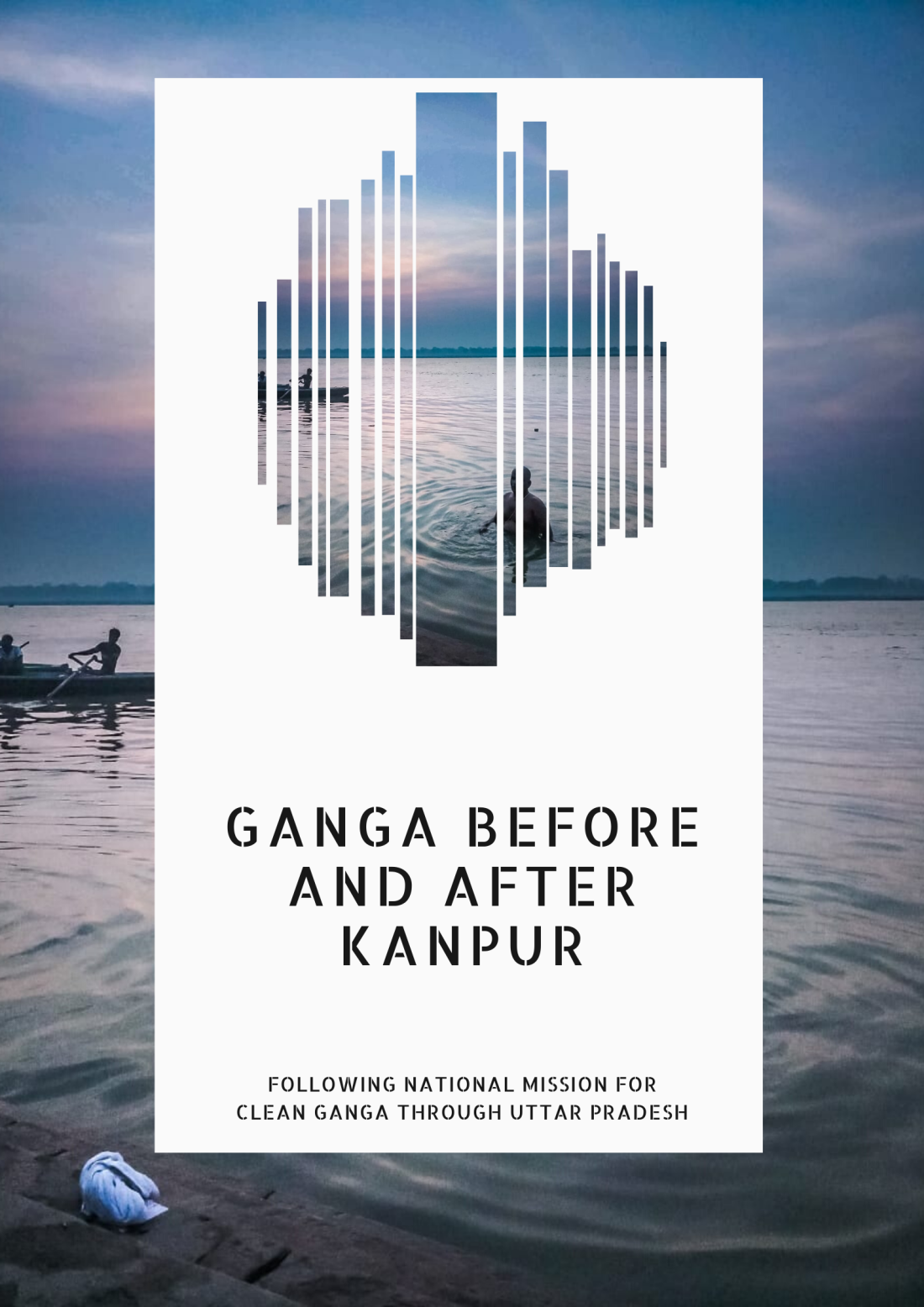 Chapter 1: Ganga Before and After Kanpur
Chapter 1: Ganga Before and After Kanpur
Kanpur is the first largest industrial town on the course of the river Ganga in Uttar Pradesh. Kanpur is home to nearly 5, 500 industries producing leather goods, shoes, belts and clothes. Kanpur is also home to 75 industries that manufacture fertilisers, pesticides, chemicals and detergents. The chemical effluents from these industries are washed off to the river stream.
People here have witnessed a change in the colour of the river. The river turns black in colour as pollution levels reach increasingly high.
Industrial effluents carrying pollutants is one of the problems that the river Ganga faces in Kanpur but many experts and citizens have noted that river starts getting depleted much before it reaches Kanpur.
Video made by Harshit Mansukhani
Ganga before Kanpur
The hydro-power project in the upper trenches of river Ganga between Uttarakhand and Uttar Pradesh have depleted the water levels. Depleted water levels in the river reduces the power of the river to wash away corpses, flowers, human and animal waste and other materials that get deposited in the river bed.
Prakash Pantola who hails from Halduchaur in Uttarakhand said, “Ganga water in Uttarakhand is clean and the current of the river is strong as well but the real problems starts when hydro-power projects such as the one on the mainstream Baghirathi influence the water of Ganga. People who live near the reservoirs of the hydro-power plants are being denied the sacred water of the river. People with the help of NGOs have sought RTIs on the construction of the projects but no concrete actions have been taken in lieu of the river water,”
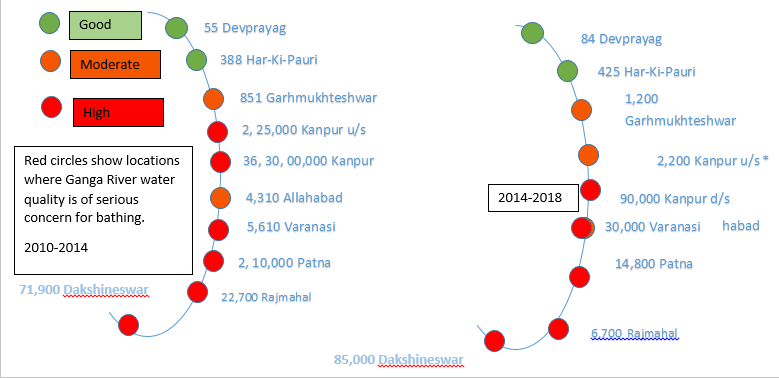
Source: CPCB- Data extrpulated and Presented by Harshit Mansukhani
The graph above concurs that the less river water in the current of the river leads to more pollution hence the problem of river pollution in Kanpur begins before the river enters Kanpur. As soon as the river leaves Kanpur for Allahabad, it has changed its color and the river water is not feasible for drinking or bathing.
Hydropower projects like the Loharinag Pala Hydro Power Project commissioned by NTPC to produce 600 MW of power is one such big-project that has impacted the flow of the river.
Mallika Bhanot, Ganga activist working with Ganga Avahaan NGO said that the real pollution of the river water is only visible due to less flow in the river.
In a telephonic interview she mentioned that the depleted river also has a psychological impact on the people living on the banks.
Here is what she had to say,
Telephonic interview was done by Harshit Mansukhani on May 8. Permission to record the call was duly taken during the initial reference call. Questions were shared beforehand.
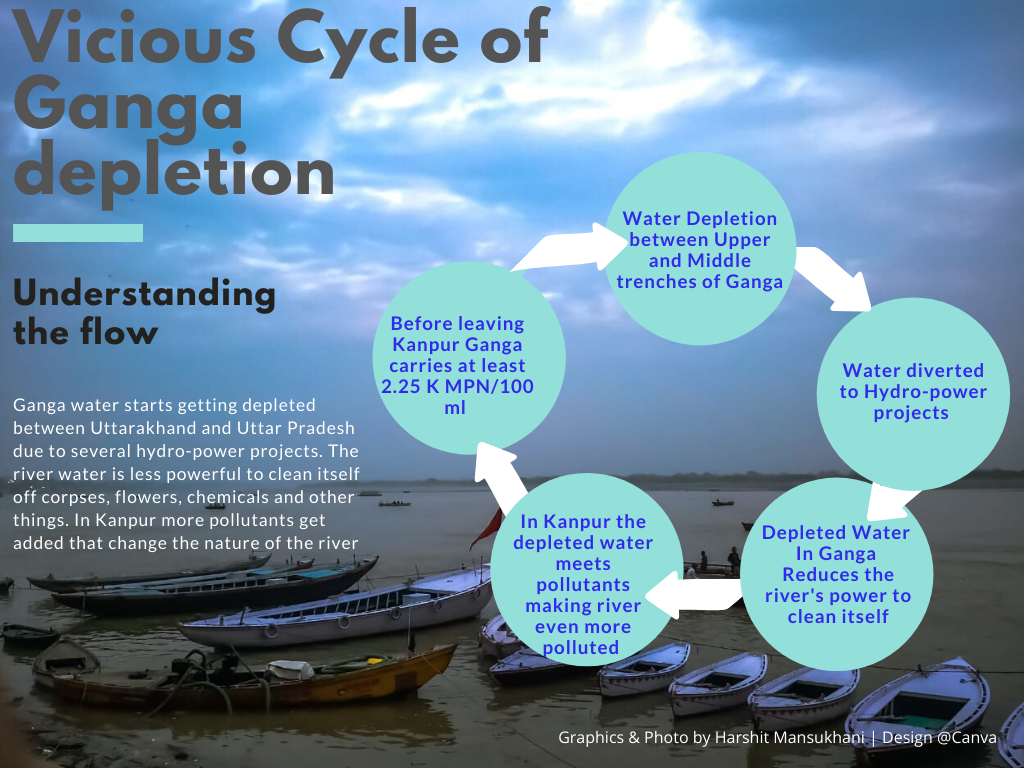
Ganga in Kanpur
Manoj Mishra, who was born and brought up in Kanpur and now lives with his family in Maharajpur area of the city said, “Sisamau sewerage drain that runs across the city before opening up near Ganga was the largest source of pollution when I was doing my higher studies. Industries since then had been using this drain to wash away pollutants. Gradually these pollutants ended up in the river. It was really crucial to tap this drain to reduce the pollutants entering the river,”
Mishra here was referring to the 200-year-old Sisamau sewerage drain which used to carry almost all of sewerage of the city before releasing it into the mainstream of the river Ganga. The aim of the National Mission for Clean Ganga (NMCG) here was to tap this drain and stop the flow of the pollutants.
Kanpur saw a two-tier approach by NMCG, part one of the mission here was to tap almost all the drains that were releasing the pollutants in the river Ganga, and second step was to upgrade the existing facilities of city’s sewerage treatment plants (STPs).
Kanpur city has only three STPs and one in Unnao city. These four STPs treat almost 190 Million Litres per Day (MLD) of waste which is only 25 percent of the total waste generated by the Kanpur city as reported by Pavitra Ganga Mission that aims to tap drainage networks pollution river Ganga.
Both Central Pollution Control Board (CPCB) and Uttar Pradesh Pollution Control Board (UPPCB) in their respective reports dated 2016 have mentioned the urgent need to stop the flow of pollutants.
Professor Emeritus & Ex-Pro-Vice-Chancellor, University of Delhi C.R. Babu who holds specialization in the studies of degraded ecosystems explains what happens to the river in Kanpur and many other industrial cities.
Babu in a telephonic interview mentioned that the installed capacities of STPs in the cities along the flow of river Ganga are less than the required amount and several of these STPs are not functioning.
The telephonic interview was done by Harshit Mansukhani on May 8. Permission to record the call was duly taken during the initial reference call. Questions were shared beforehand.
The flow of the River Ganga through Uttar Pradesh[/caption] Made by Harshit Mansukhani om interactive maps
Understanding failures of Ganga Action Plan (GAP) and the journey after Kanpur
Dhabka Ghat drain is one of the four major drains that carry toxic water to my banks from 400 tanneries of Jajmau. As an initiative under the Ganga Action Palan (GAP) in 1986, all these drains were connected to four intermediate pumping stations that flush this toxic water to a common effluent treatment plant at Wajidpur. This CETP plant features a capacity to treat just 9 MLD of commercial wastewater and 27 MLD of sewage.

Also, due to lack of vision, infrastructure,and urban planning that was conceived in 1986, GAP could serve only 175 tanneries in Kanpur and could treat nine MLD effluents. Under GAP 40 MLD of industrial effluent was flowing into the river between 1986 and 2014. (Ganga Action Plan)
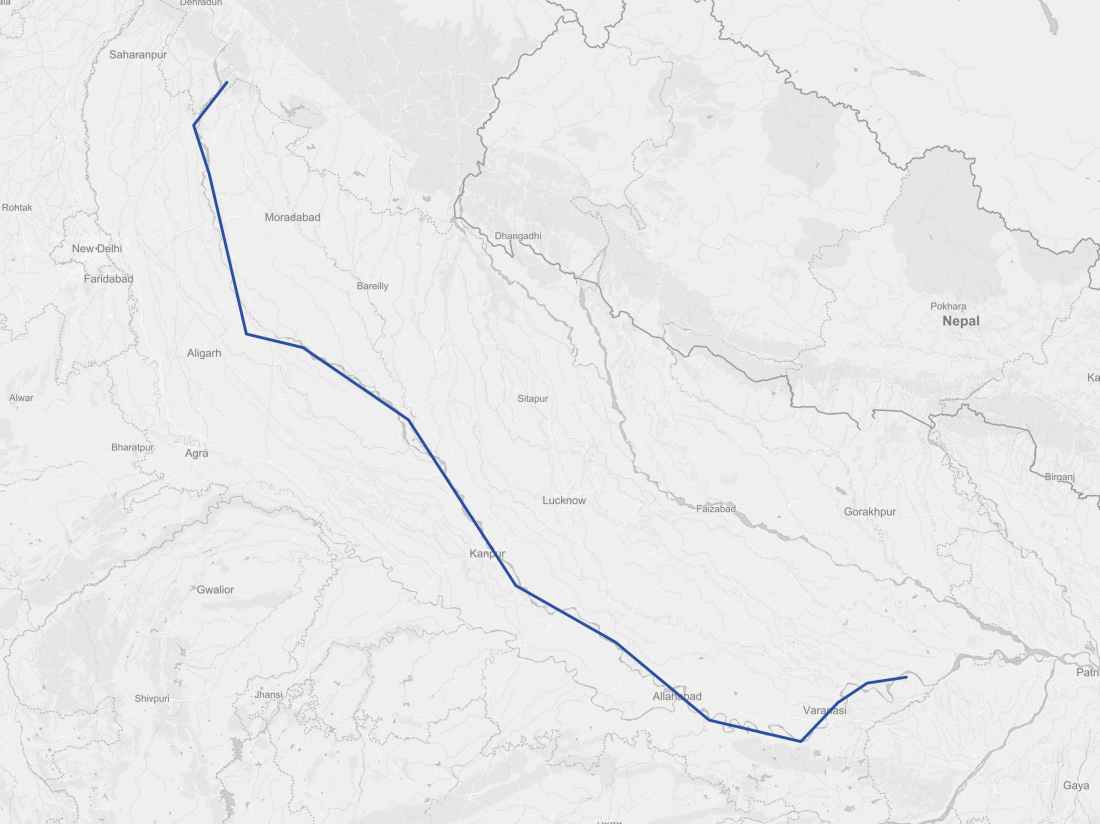
The flow of the River Ganga through Uttar Pradesh[/caption] Made by Harshit Mansukhani on interactive maps
The river Ganga now flows towards Prayagaj, formerly known as Allahabad where it meets its tributaries Yamuna and Saraswati at Triveni Sangam (Meeting point of three rivers), which is considered by many Indians as the most pure spot in the entire flow of the river.
Bhim Singh Rawat, Assistant Coordinator of South Asia Network on Dams, River,and People (SANDRP) in the mailb honic interview further mentioned, “A review of the Central Water Commission (CWC) monitoring reports of all four quarters of 2019 reveals that all the eleven projects that were being monitored in Ganga basin have violated the mandatory Environment flows notification in each of the four quarters of 2019 at some time or the other. The reports are of poor quality with CWC forgetting which states are in Ganga basin and even relative location of the projects. The CWC also seems to have no clue as to what constitutes Environment flows. No punitive action is initiated in any of the cases of violations even after the e flows notification implementation becomes legally mandatory from December 15, 2019 as per the NMCG notification of Sept 14, 2019.
On Oct 9, 2018, the National Mission on Clean Ganga (1) (NMCG) under Union Ministry of Water Resources, River Development and Ganga Rejuvenation (MoWR for short) came out with a notification on mandatory Environment flows in Ganga.”
He added, “The Central Water Commission (CWC) was responsible under the notification for “supervision, Monitoring, regulation of flows and reporting necessary information to reporting authority” and was mandated to “submit flow monitoring-cum-compliance report on quarterly basis” to NMCG. The choice of CWC for this monitoring and regulatory task is problematic because CWC is a subordinate organisation of MoWR, monitoring and compliance agency should have been independent agency. Moreover, CWC has very poor track record in terms of valuing environment flows or rivers.”
“Amongst purifiers, I am the wind, and amongst wielders of weapons, I am Lord Ram. Of water creatures, I am the crocodile, and of flowing rivers, I am the Ganga.” – Bhagavad Gita, Chapter 10, Verse 31.
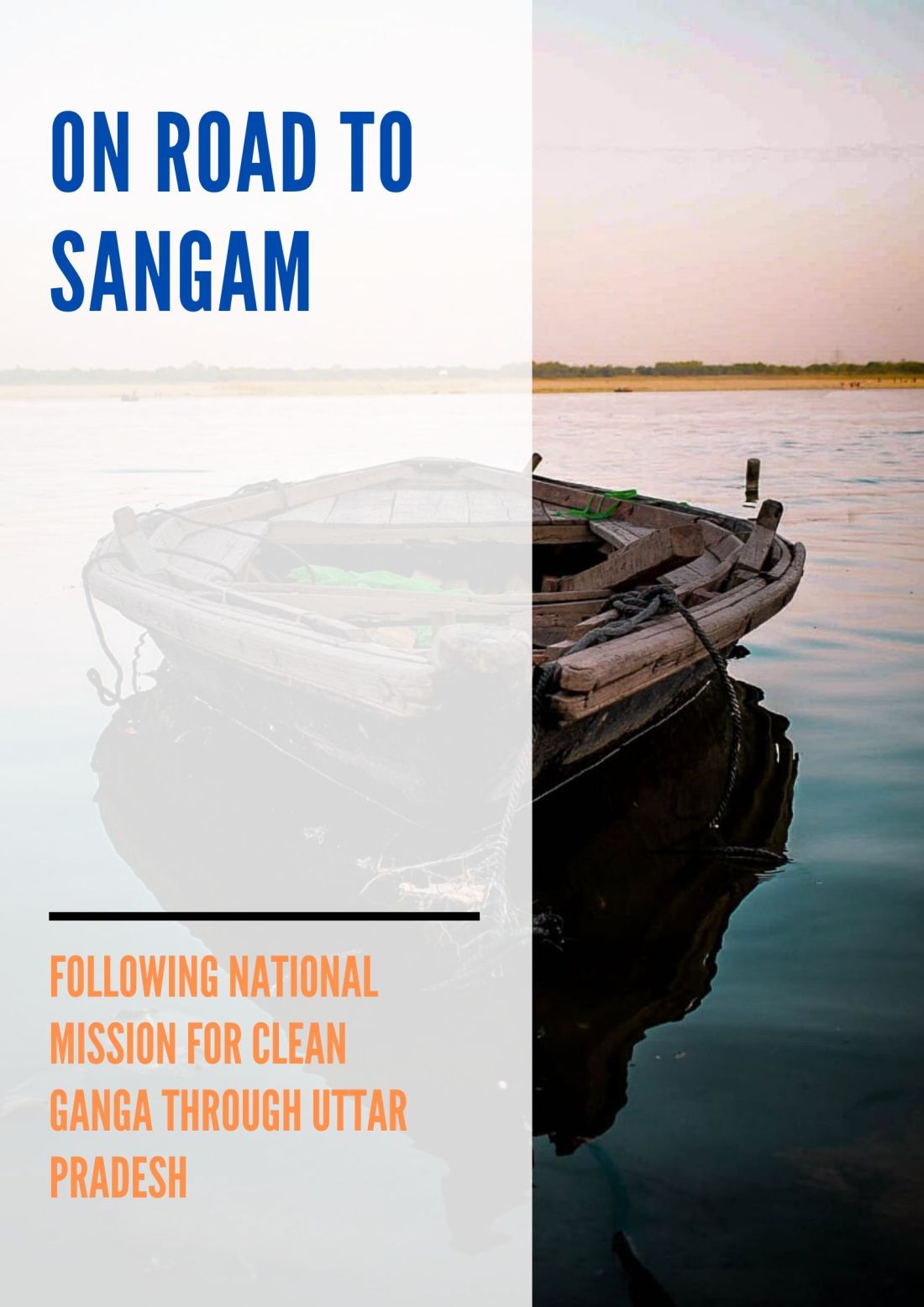
Chapter 2: On Road to Sangam
Ganga has so far travelled 965 Kms from Gaumukh to holy town of Allahabad where it meets two other rivers namely the Yamuna that flows through the national capital, Delhi and another mystical river, Saraswati. These three rivers meet at Triveni Sangam (Meeting point of three rivers) in Allahabad and this point is considered the most pure spot to take a bath. Ganga faces a new trouble here. The sewerage system of Allahabad is the new problem that the river has to face here.
The system here is currently overwhelmed by the load of sewer created each day. Installed facilities in the towns are not enough to treat the drainage and the waste flows through to the river Ganga. The garbage generated by the daily prayers, special prayers and other religious offering on the ghats of the river also add to the waste of the river.
Allahabad has been divided into seven sewerage districts and one township for planning and `implementation of sewerage infrastructure. The sewage generation within the town is estimated to be 300 MLD by 2035.
As per a study conducted by TERI (The Energy and Resources Institute) there are 57 drains in the city that discharge waste in the river Ganga. Some of these drains have been tapped under GAP I and GAP II (Ganga Action Plans) while rest have to be tapped by the joint initiative of UPJN (Uttar Pradesh Jal Nigam) and local bodies.
Ganesh Singh, 54, a resident of Allahabad said, “The water of Ganga Ma was clean when I was a child. My friends and I used to stop at Ghats on our way back to home from school to witness the flow of Ma Gange. This river and I both have changed. I went to a different place for education and could not see the river while the river water got polluted. Today, the river has changed so much that I could hardly remember what it was like in my childhood. The Ghats were so clean that we used to play a marble game by the river-side. In modern days these things are not possible. The river has changed and so have people around it.”
Meanwhile, NMCG has undertaken the re-construction work of the sewerage system in the city.
NMCG had divided the city into seven sewerage districts A-G. In these districts the NMCG will carry out the re-construction work,
However, there is a flipside to the re-development as well.
- Pollution in terms of dust generation is that the next problematic area and eventually basic services like water and electricity lines can be damaged.
- Traffic congestion is the second most important side-effect to be considered here while undertaking a project of this scale.
- The most crucial consideration is the human cost. Any re-development comes it with adverse impacts on living beings around the work site. Deadly fumes from sewer gases such as Hydrogen sulphide, ammonia, methane, esters, carbon monoxide, sulphur dioxide and nitrogen oxides can prove to be fatal for some human beings.
- Finally, the fragile system could collapse while the reconstruction phase is going on which will have adverse impact on the river system.
Bhim Singh Rawat, Assistant Coordinator of South Asia Network on Dams, River and People (SANDRP) explains that the reconstruction of a huge sewerage system and Ghats will affect the daily-life majorly. He mentioned that Allahabad will also have to bring changes in its daily life to protect the river from getting deteriorated.
As per the official NMCG data dated March 2020, there are seven sewerage redevelopment projects that have been completed. Sewerage & Non-Sewerage schemes for pollution abatement of River Ganga at District-‘B’ & ‘E’ of Allahabad have been completed. Meanwhile, Sewerage & Non-Sewerage schemes for pollution abatement of river Ganga at District-‘A’ of Allahabad have been completed.
These two projects cost Rs 242 crores and together cover 21 KMs of sewerage network in the city. These two specific projects are directly linked to the abetment of pollution of river Ganga.
Prof. Babu also explained the possible repercussions if the pollution in Allahabad remains unchecked.
Meanwhile, NMCG also has laid down the guidelines of the Ghats, STPs and sewerage reconstruction.
Mallika Bhanot Ganga Activist with Ganga Avahan NGO echoed the statement made by Prof. Babu. She said, “
Ganga a living entity?
Uttarakhand High Court in 2017 passed an order that declared rivers Ganga and Yamuna as “living entity” and granted them equal citizen rights. This was done on the basis of a judgement passed in New Zealand that declared a river there as a living entity. The Supreme Court of India put a stay on the High Court judgement for Ganga and Yamuna as it may create various legal troubles for those who act as the custodians of the river. This decision of the Uttarakhand High Court was on the basis that holy sadhus who gather in Allahabad for one of the largest religious gatherings in the world, Maha Khumb have often complained about lack of water and threaten to boycott the festival. The judgement will be discussed in detail later in Chapter three on Varanasi, where the river really comes to life.
Chapter 3: In Varanasi: Ganga looking for Moksh
One gigantic river flows into Varanasi having left Allahabad after meeting its tributaries. This form of Ganga will pass through four states before opening up in the Bay of Bengal. Varanasi or Banaras is one of the oldest towns in the world. It is home to hundreds of temples, multiple ghats where people want to breathe their last breath. Varanasi is also home to Banarasi Sarees and Banrasi Paan. The city has been an educational hub for centuries with institutions like Banaras Hindu University (BHU) and IIT.
Varanasi has a special sanctity, for it is believed, this is where the Hindu God, Lord Shiva and his wife Parvati stood when time started ticking for the first time.
The city also holds a significant position in the national politics. It serves as the electoral constituency of Prime Minister Narendra Modi.
Varanasi also hold the most significant value on the course of the river. The streets are filled with aroma of prayer materials and it hard to imagine how this old crowded city is still developing.
The main problem the river faces here is three-tier. The Ghats on the river banks are under-developed for everyday use. Lack of basic amenities such as dustbins, washing centres and waste disposal have made the river a prime recipient of the waste generated by the devotees. Secondly, people come in numbers here to find salvation or moksh from the cycle of re-birth. The mortal remains of the people who died and are cremated in Varanasi is discharged into Ganga and additionally, corpses of unclaimed humans and animals either half-burnt or full burnt are released into the river. These corpses release gases that pollute the river water and depletes it off the naturally dissolved oxygen. Finally, the sewerage system of the city is the third problem that NMCG has to face.
| Station-Location | Distance in Kms. | Dissolved Oxygen during 1986 (mg/l) | Biological Oxygen Demand in 1986 (mg/l) | Dissolved Oxygen during 2011 (mg/l) | Biological Oxygen demand during 2011 (mg/l) |
| Rishikesh | 0 | 8.1 | 1.7 | 7.6 | 1.4 |
| Hardwar D/s | 30 | 8.1 | 1.8 | 7.4 | 1.6 |
| Garhmukteshwar | 175 | 7.8 | 2.2 | 7.5 | 1.7 |
| Kannauj U/S | 430 | 7.2 | 5.5 | 7.9 | 1.7 |
| Kanpur U/S | 530 | 7.2 | 7.2 | 7.7 | 3.3 |
| Kanpur D/S | 548 | 6.7 | 8.6 | 7.6 | 3.8 |
| Allahabad U/S | 733 | 6.4 | 11.4 | 7.8 | 5.3 |
| Allahabad D/S | 743 | 6.6 | 15.5 | 7.8 | 5.1 |
| Varanasi U/S | 908 | 5.6 | 10.1 | 8 | 2.9 |
| Varanasi D/S | 916 | 5.9 | 10.6 | 8 | 4.3 |
| Patna U/S | 1188 | 8.4 | 2 | 7 | 1.8 |
| Patna D/S | 1198 | 8.1 | 2.2 | 7.1 | 2.5 |
| Rajmahal | 1508 | 7.8 | 1.8 | 6.8 | 1.5 |
Data set created by Harshit Mansukhani. Data from CPCB 2016 report
Under-development of ghats and religious faith of people are two extreme cases and have to be dealt with in different manner.
For Ghat Re-development NMCG has listed 87 Ghats that include the Manikarnika Ghats and other ghats where Ganga prayers take place
NMCG has laid down the points of redevelopment of Ghats. These Ghats would be redeveloped on the basis of these several considerations.
All Ghats redeveloped under NMCG in Varanasi will have:
- Change Rooms
- Toilets
- Solar Lighting / High Mast Lights
- Drinking-Water Facilities
- ATMs
- Souvenir shops
- Chabutras for Seating
- Repairing of Existing steps
- Bathing Platforms Edge Protection Works Railing
- Safety Chains
- Trash Bins
- Composters

The tenders for Ghat redevelopment were first floated out in 2016 and said, “The National Mission for Clean Ganga invites sealed tenders in two stage bid system i.e. technical and financial bid separately from reputed and experienced firms/contractors for(i) Prevention of solid waste coming from drains from entering into river, its collection and disposal; (ii) Collection of all kinds of floating waste from river surface and its disposal; (iii) Collection and disposal of solid waste from the banks of river up to maximum of 100m from waterline (varying with season)and preventing it from entering the river including disposal of waste from cremation ghats and disposal of dead animals from banks etc.; (iv) Keeping the ghats clean and litter free providing amenities like dustbins, toilets, changing rooms in Varanasi Town.”
People who have lived in Varanasi have said that a clean Ganga boosts economy of the city and keeps the population engaged in different economic activities.
Shilpi Tandon, Senior Manager , Corporate Communications, GAIL India Limited who looks after the CSR efforts of GAIL India towards Ganga and was born and brought up in Varanasi said, “ A cleaner river boosts economy as recreational trips such as river-rise, ferries, light and sound show can be thought of. Since the river is dirty and no such activity can be done, it forces the youth to leave the city for a better job offer. I have seen people living in Varanasi and coming back empty-handed just to repent their losses in front of the river. This river has the capacity to feed, and become economic source for millions of people only if it is clean and healthy. The clean river also has an impact on Banaras Sarees industry which thrive on the proximity to the holy river. It is all connected to having a cleaner river. NMCG program has achieved bits of it but there is more scope.”
Photos by Harshit Mansukhani
Professor C.R. Babu Professor Emeritus said
Ganga a living entity?
In March 2017, Uttarakhand High Court passed a head-turning verdict declaring Yamuna and Ganga rivers as “living entity”, which the court saw as an opportunity to treat the rivers as a person with same rights shared by all Indian citizens thus, a measure to control pollution in the rivers. This verdict declared that the river pollution will be seen as a possible attack on the rights of any citizens. It was celebrated by the activists and people alike. The court said that the verdict was based on the court case on Whanganui River, revered by the indigenous Māori people, which was declared a living entity with full legal rights by the New Zealand government.
However, in June 2017 the Supreme Court of India put a stay order on the High Court declaration. The rivers have not been granted the same rights as human for several reasons.
Justice Sunil Ambwani, Former Chief Justice of Rajasthan High Court (2015-2016) and a Judge at Allahabad High Court (2001-2014) in a telephonic interview told that the judgement by the High Court was flawed on various grounds and that the Supreme Court will put it aside.
Justice Ambwani has specialisation in environment and pollution legal cases. He gave rare insights into the judgement and talked about its fallacies. He also reiterated the fact that river water in the upstream Ganga is getting depleted due to the hydro-power projects. He said, “People who live behind the reservoir’s on Ganga stream in places like Narora and Bulandshar in Uttar Pradesh don’t believe in the holiness of the water. They say that the reservoir water is not Ganga water and therefore they will boycott the use of such water.”
He also said that, “the holy priests who attend Mahakhumb often complain about the lack of water in the river and threaten to boycott the festival. In light of this every year Allahabad High Court releases an order asking hydro-power plants to release more water. It takes 3-4 days for the water to reach Allahabad from Narora and once the water reaches Allahabad the river cleans itself completely,”
Justice Ambwani points out at the two-tier correction method for cleaning the river. He says that there has to be a constant low maintained in the river. At the same time National Green Tribunal must take cognisance of polluting industries in Kanpur and Allahabad that shall re-open after nation-wide lockdown imposed due to SARS-CoV2 or Coronavirus pandemic.
He said, “There are videos which indicate that the river water in Rishikesh in Haridwar have become clean enough for drinking and bathing again. Both UP and Central Pollution Boards have time and again warned that the river water is unfit. The nature has its own form of taking back what it gives and coronavirus pandemic is one of them.”
Ganga During and After Coronavirus Pandemic
Professor Babu said, “More than the government programs, a pandemic has helped rejuvenate the river, We have read in the newspapers that one can now witness dolphins in river Ganga. The factories along side river ganga have been locked down due to the pandemic, when they get back to business as usal we should not 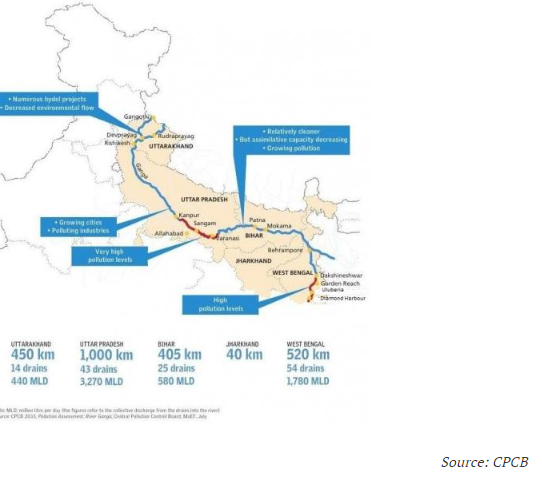 journey back to zero.”
journey back to zero.”
All experts have called for a media campaign on the awareness of pollution in the river Ganga and especially in three cities Kanpur Allahabad and Varanasi.
An overview of the challenges river Ganga face in its course of 2525 KMs
“One may, by putting forth one’s best powers, count the stones that occur in the mountains of Meru or measure the waters that occur in the ocean, but one cannot count all the merits which belong to the waters of Ganga.” – Mahabharata, Anusasana Parva, Chapter 27, Verse 97
In A Nutshell
Learning and Unlearning were the state of the nature during this project. The greatest takeaways abut Ganga is in the fine-lines between what the people living along the river have to say about the river and what experts have mentioned.
Uday Jha, who has lived near Ganga in Bihar and has made visits to all three towns of Uttar Pradesh said, “The initial right of river water lies with the river itself. There is no way that humans should fight on what is not theirs. Many of them still have this thinking that even if the clothes of river Ganga is dirty, the river is still pure. It is not. The river bed is still as dirty as the surface of the river. I recollect that my friends and I used to make paper boats and float it in the river Ganga. The person whose boat went the farthest before being drowned used to win. It cannot happen today, Industrialisation has its own pros and cons.”
This project is a big learning curve. Starting with Ganga being declared a living entity, the Supreme Court proceeded with its judgement and said it is not a living being. The activists still consider it a living body. People are divided between the holiness of water behind the reservoir. Many are complaining that the river water is low for a festival to go on. Others just seek salvation on the banks of Ganga. And between this maze, Ganga is cleaning itself during the brief respite. The river, without question remains to be the most important economic source to much of India that lives on its banks. Ganga is not only a source of economic fulfilment but also a source of religious ideology and a sense of existence. The river continues to be a sacred belief of people. These people have believed that Ganga Jal (Water of Ganga) has healing powers and on the basis of that belief, the religious connect has continued for thousands of years.
Many call her Ma Gange (Mother Ganga) and why not! If Ganga can be the mother of Bhishma Pitama, one of the most crucial persons in sacred text of the Hindus, Mahabharata, then it can definitely be mother to millions of Indians; Indians who yearn to meet her once in their lifetime and if they are lucky, breathe their last breath on the banks of Ganga. This has been the journey of a lifetime for the author as he explored the only crucial, single link between millions of Indians. The journey itself has purified the project and the author, such is the power of Ganga that is shared throughout the Indian land.
People who helped during the project
- Pamela Srivastava- helped in ideation of the project
- Sanskruti Yagnik-Drafting of questions for Justice Ambwani
- Prakash Pantola- Finding out sources in Varanasi
- Sanjam Cheema- For elaborating on the NMCG program
- Rajesh Mansukhani- ideation, way forward, indexing
- Professor Sunil Saxena- Guiding, Mentoring and suggesting way forward in the project
Bibiliography
Websites
- https://nmcg.nic.in/pdf/Vision%20Ganga%20Eng_Compressed.pdf
- https://data.gov.in/catalog/water-quality-data-river-ganga?filters%5Bfield_catalog_reference%5D=94693&format=json&offset=0&limit=6&sort%5Bcreated%5D=desc
- file:///C:/Users/Harshit%20Mansukhani/Downloads/iajt05i4p115%20(1).pdf
- http://www.uppcb.com/pdf/ganga-note_210917.pdf
- https://pib.gov.in/newsite/PrintRelease.aspx?relid=175320
- https://www.who.int/water_sanitation_health/wsh0404.pdf
- National Mission for Clean Ganga
- MINISTRY OF JAL SHAKTI, DEPARTMENT OF WATER RESOURCES,RIVER DEVELOPMENT & GANGA REJUVENATION
- World Health Organisation
- CSE
- https://sandrp.in/2020/03/19/implementation-of-nmcgs-ganga-river-e-flows-in-2019-all-projects-violating-minimalist-norms/#_edn2
- https://www.ndtv.com/india-news/no-yamuna-and-ganga-are-not-living-entities-says-supreme-court-1721833
- https://www.theguardian.com/world/2017/mar/21/ganges-and-yamuna-rivers-granted-same-legal-rights-as-human-beings
- https://www.hindustantimes.com/india-news/some-ganga-stretches-now-cleaner-cpcb/story-kpWW5DuCMJJHwa9ds7XNqJ.html
Reports
- Pollution and Conservation of Ganga River in Modern India
- Water Pollution Control – A Guide to the Use of Water Quality Management Principles
- NMCG Report
- https://nmcg.nic.in/Annual_Reports.aspx
- https://nmcg.nic.in/writereaddata/fileupload/11_Environmental%20and%20Social%20Management%20Framework%20Annexure%201%20baseline%20%20Ganga%202.pdf

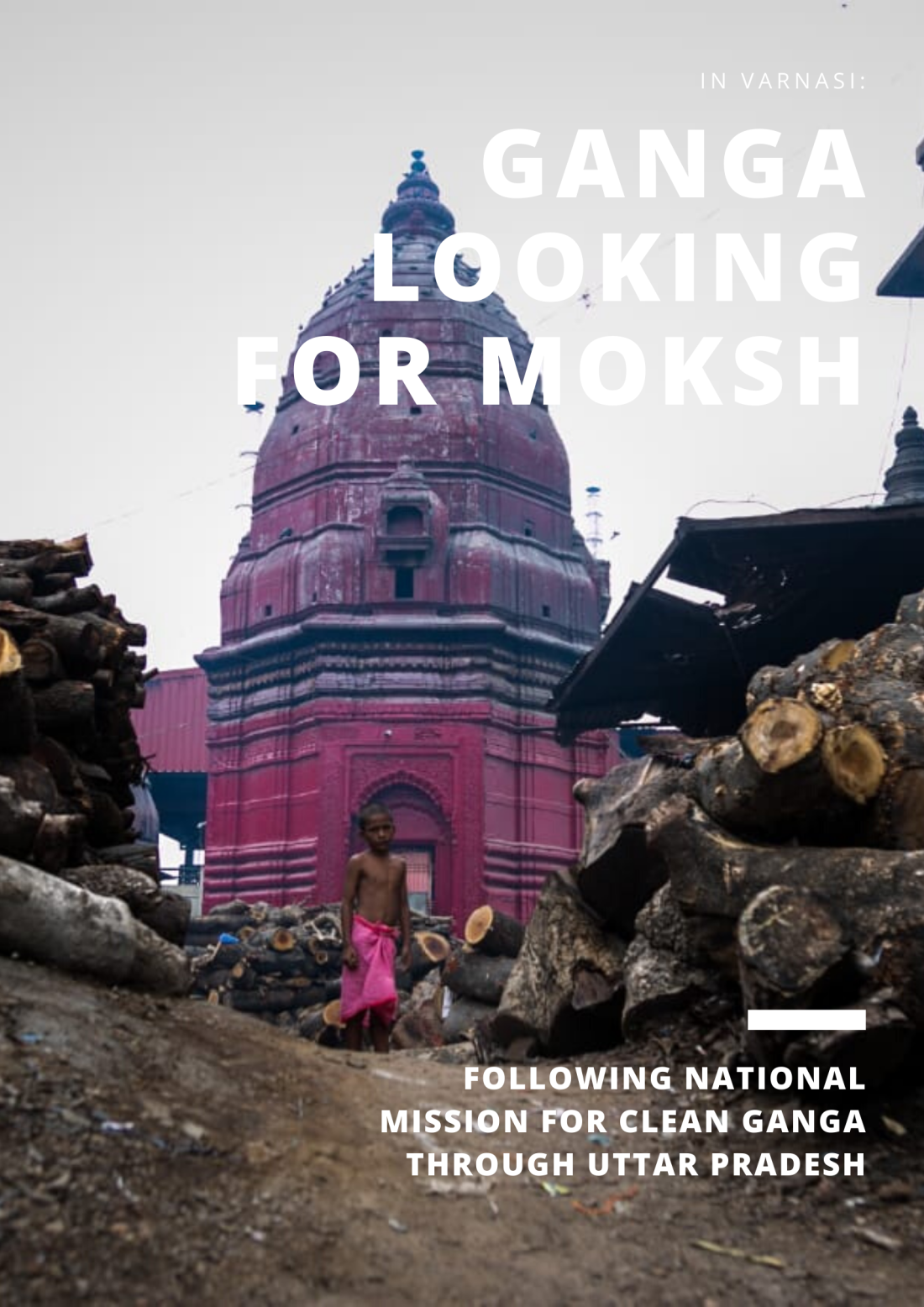


![PHOTO-2020-01-02-14-05-05[1] PHOTO-2020-01-02-14-05-05[1]](https://i0.wp.com/faultliness.com/wp-content/uploads/2020/05/photo-2020-01-02-14-05-051.jpg?w=391&h=261&ssl=1)

![PHOTO-2020-01-02-14-05-10[1] PHOTO-2020-01-02-14-05-10[1]](https://i0.wp.com/faultliness.com/wp-content/uploads/2020/05/photo-2020-01-02-14-05-101.jpg?w=515&h=386&ssl=1)



![PHOTO-2020-01-02-14-05-07[1] PHOTO-2020-01-02-14-05-07[1]](https://i0.wp.com/faultliness.com/wp-content/uploads/2020/05/photo-2020-01-02-14-05-071.jpg?w=435&h=290&ssl=1)



![PHOTO-2020-01-02-14-04-56[1] PHOTO-2020-01-02-14-04-56[1]](https://i0.wp.com/faultliness.com/wp-content/uploads/2020/05/photo-2020-01-02-14-04-561.jpg?w=301&h=527&ssl=1)
![PHOTO-2020-01-02-14-04-59[1] PHOTO-2020-01-02-14-04-59[1]](https://i0.wp.com/faultliness.com/wp-content/uploads/2020/05/photo-2020-01-02-14-04-591.jpg?w=791&h=527&ssl=1)
Quite in-depth reasearch. Explicitly reveals unknown facts. The thesis is an example of your toil and perseverance.Play up..play the game…Alwayzzz….God bless.
Thank you 🙂
Congratulations Harshit! This project indeed is a reflection of your dedication and commitment to your goals! A lot of research has gone into the project! Hope you continue to work with the same intention and passion always!
Delivered as expected…..stand out work & many congratulations……hope this could be further advanced in realising the mission
Thank you for your kind words, Sir. The mission should really be realised. Thanks again 🙂
Good work Harshit, you made all of us proud, specially your mother. God bless, keep the good work going. Hope these realistic work get some desired action and purpose is realised.
Thank you sir. Indeed, Looking forward to the mission being implemented
Very well structured, and ideas are clear. You managed to successfully express the importance of your research, from both a theoretical and an applied perspective.
Well done Harshit..and All the best..
Amul Sharma
Thank you 🙂
Very elaborate study on river Ganga.I learnt many new aspects about river Ganga.keep doing good work all the best.
Thank you ma’am
Very well explained,GoodJob. All the best
Thank you ma’am
Hi
I hav gone through ur proj, which is covered in a logical & a coherent manner. U have gone in great detail and hav carried out thorough examination of complete seq of events which hav lead to present state of Ganges. It comes to my mind and I strongly recommend that run of the river hydro plants must be created for power gen. It won’t divert water elsewhere and won’t affect rivers power to clean itself.
On one hand a broken connect of psy and spiritual beliefs of one sector of society and on the other hand superstitious calls by other sector may give rise to implications which may be catastrophic in nature. I have many things to say but I will pause here.
A brilliant piece of work done by u signifies the indomitable spirits and the highest traditions of Indian society, who will work their way out for betterment of all
Inshalla barkat
Amay Khanna
Thank you so much sir for your kind words. I agree with your point. The Ganga is divided between so many believes. I would wanted to go more deep and capture people’s lives but COVID-19 and limited resources restraint me. I would have loved to cover more human aspect. Thank you for your words and please stay safe. Regards HM
I have just completed reading your article on Namami Gange. It was an exceptionally well-written article and created many interesting facts on the subject.
I particularly liked the fact that it was an objective look and covered very important aspects about Ganga.
Truly appreciate your dedication.
All the very best for your future endeavors.
Regards
Ruchi Khanna
Thank you for your kind words ma’am
Hi,
1. The article on Namami Gange is best ever article I have ever read.
2. The article is well covered with miniscule details related to Ganga before and after.
3. I would recommend my friends and colleagues to go through this article as it provides great insight on the topic which would increase their knowledge
Regards
Sure Sir, Thank You
Its exceptionally well written after a thorough research, covering varieties of sub-subjects.
Thank you sir
Quite a sad state of affairs. Nice work highlighting the issues associated with the mighty river.
Deity Ganga..is a symbol of purity..for me for u and for all of us..I think it’s our turn now to keep clean our diety Ganga Ma..Really good initiative..i hope our government and people understand it.
True! Thank you